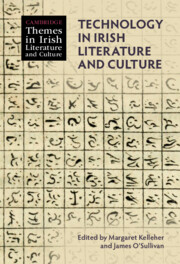36 results
Chapter 14 - Irish Literary Feminism and Its Digital Archive(s)
- from Part IV - The Digital
-
-
- Book:
- Technology in Irish Literature and Culture
- Published online:
- 19 January 2023
- Print publication:
- 26 January 2023, pp 235-252
-
- Chapter
- Export citation
Part IV - The Digital
-
- Book:
- Technology in Irish Literature and Culture
- Published online:
- 19 January 2023
- Print publication:
- 26 January 2023, pp 233-326
-
- Chapter
- Export citation
Part III - Invention
-
- Book:
- Technology in Irish Literature and Culture
- Published online:
- 19 January 2023
- Print publication:
- 26 January 2023, pp 135-232
-
- Chapter
- Export citation
Epigraph
-
- Book:
- Technology in Irish Literature and Culture
- Published online:
- 19 January 2023
- Print publication:
- 26 January 2023, pp v-vi
-
- Chapter
- Export citation
Copyright page
-
- Book:
- Technology in Irish Literature and Culture
- Published online:
- 19 January 2023
- Print publication:
- 26 January 2023, pp iv-iv
-
- Chapter
- Export citation
Contents
-
- Book:
- Technology in Irish Literature and Culture
- Published online:
- 19 January 2023
- Print publication:
- 26 January 2023, pp vii-viii
-
- Chapter
- Export citation
Acknowledgements
-
- Book:
- Technology in Irish Literature and Culture
- Published online:
- 19 January 2023
- Print publication:
- 26 January 2023, pp xv-xvi
-
- Chapter
- Export citation
Part II - Infrastructures
-
- Book:
- Technology in Irish Literature and Culture
- Published online:
- 19 January 2023
- Print publication:
- 26 January 2023, pp 81-134
-
- Chapter
- Export citation
Introduction
-
-
- Book:
- Technology in Irish Literature and Culture
- Published online:
- 19 January 2023
- Print publication:
- 26 January 2023, pp 1-8
-
- Chapter
- Export citation
Index
-
- Book:
- Technology in Irish Literature and Culture
- Published online:
- 19 January 2023
- Print publication:
- 26 January 2023, pp 327-336
-
- Chapter
- Export citation
Contributors
-
- Book:
- Technology in Irish Literature and Culture
- Published online:
- 19 January 2023
- Print publication:
- 26 January 2023, pp ix-xiii
-
- Chapter
- Export citation
Part I - Genealogies
-
- Book:
- Technology in Irish Literature and Culture
- Published online:
- 19 January 2023
- Print publication:
- 26 January 2023, pp 9-80
-
- Chapter
- Export citation

Technology in Irish Literature and Culture
-
- Published online:
- 19 January 2023
- Print publication:
- 26 January 2023
Chapter 5 - Famine and Ecology, 1750–1900
-
-
- Book:
- A History of Irish Literature and the Environment
- Published online:
- 14 July 2022
- Print publication:
- 28 July 2022, pp 115-133
-
- Chapter
- Export citation
18 - Literary Revolution: Ireland and the World
- from Part III - Transregional Worlding
-
-
- Book:
- The Cambridge History of World Literature
- Published online:
- 17 August 2021
- Print publication:
- 09 September 2021, pp 343-359
-
- Chapter
- Export citation
Chapter 15 - “One Hundred Years a Nation”: New Modes of Commemoration
- from Part Three - Forms and Practices
-
-
- Book:
- The New Irish Studies
- Published online:
- 18 September 2020
- Print publication:
- 24 September 2020, pp 259-274
-
- Chapter
- Export citation
Chapter 19 - Curriculum to Canon: Irish Writing and Education
- from Part V - Retrospective Frameworks: Criticism in Transition
-
-
- Book:
- Irish Literature in Transition, 1940–1980
- Published online:
- 28 February 2020
- Print publication:
- 12 March 2020, pp 344-358
-
- Chapter
- Export citation
Chapter 20 - Contemporary Literature and Public Value
- from Part IV - Practices, Institutions, and Audiences
-
-
- Book:
- Irish Literature in Transition: 1980–2020
- Published online:
- 28 February 2020
- Print publication:
- 12 March 2020, pp 375-391
-
- Chapter
- Export citation
Contributor affiliations
-
-
- Book:
- Textbook of Neural Repair and Rehabilitation
- Published online:
- 05 May 2014
- Print publication:
- 24 April 2014, pp ix-xvi
-
- Chapter
- Export citation



